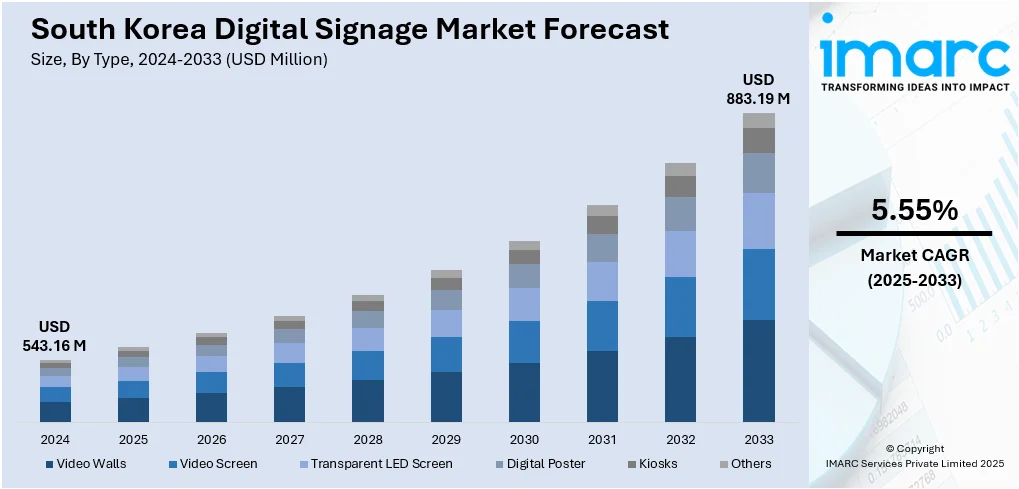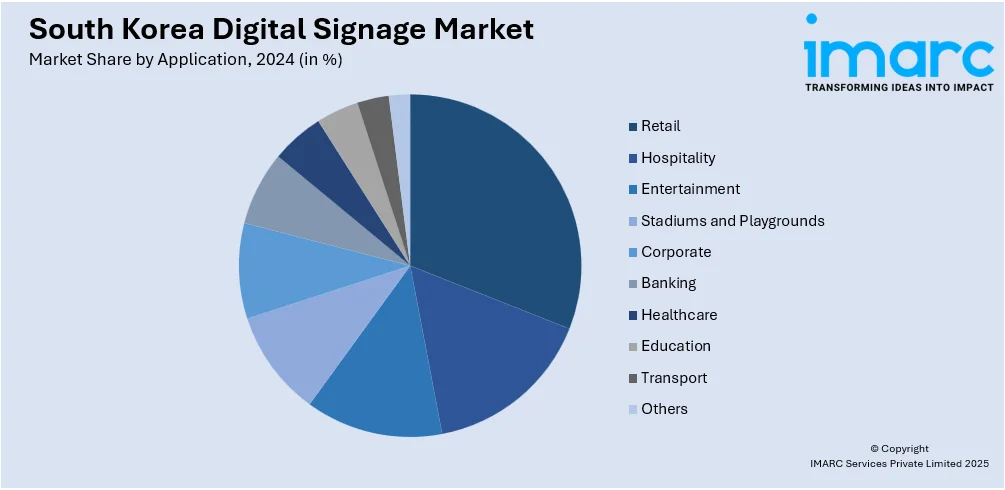
South Korea Digital Signage Market Size, Share, Trends and Forecast by Type, Component, Technology, Application, Location, Size, and Region, 2025-2033
South Korea Digital Signage Market Overview:
The South Korea digital signage market size reached USD 543.16 Million in 2024. The market is projected to reach USD 883.19 Million by 2033, exhibiting a growth rate (CAGR) of 5.55% during 2025-2033. The market is driven by rapid adoption of smart technologies like artificial intelligence (AI), Internet of Things (IoT), enabling interactive and personalized content across retail, transportation, and public sectors. Expanding urban infrastructure and modernized transit systems create high-traffic environments ideal for dynamic displays. Additionally, strong government support through smart city initiatives and digital transformation policies accelerates deployment in public and commercial spaces. This synergy of innovation, infrastructure, and policy positions digital signage as a vital tool in South Korea digital signage market share.
|
Report Attribute
|
Key Statistics
|
|---|---|
|
Base Year
|
2024
|
|
Forecast Years
|
2025-2033
|
|
Historical Years
|
2019-2024
|
| Market Size in 2024 | USD 543.16 Million |
| Market Forecast in 2033 | USD 883.19 Million |
| Market Growth Rate 2025-2033 | 5.55% |
South Korea Digital Signage Market Trends:
Adoption of Smart Technologies and Interactive Displays
South Korea's proactive adoption of technology is a major driving force for South Korea digital signage growth. Companies and public establishments are rapidly transitioning away from static signage towards intelligent signage solutions that utilize AI, IoT, and machine learning (ML). These technologies enable signage to become interactive, responding to user input, adapting to environmental changes, and adjusting content in real time based on audience behavior. This provides an interactive, bespoke experience that cannot be offered by conventional media. As customers demand digital interaction in almost all aspects of life, from shopping to learning, companies are investing in signage that accommodates smart functionality. Digital signs allow real-time updates , minimizing the need for manual labor and increasing content accuracy. As South Korea accelerates digital innovation, this need for smart, responsive display solutions is emerging as a hallmark of its signage market.

To get more information on this market, Request Sample
Retail and Transportation Infrastructure Driving Demand
Expansion of retail facilities and transport infrastructure throughout South Korea is driving the widespread adoption of digital signage. Retail settings from shopping malls to street-level boutiques—are increasingly adopting digital screens to capture customer attention, promote products, and create immersive brand experiences. Similarly, transport nodes like subways, airports, and bus stations depend on dynamic signage to communicate information, ads, and directions to commuters. These high-traffic spaces are enhanced by the flexibility and transparency that digital signage allows. Companies view these spaces as ideal for targeted messaging with the flow of diverse audiences continually moving through them. Additionally, integration with navigation systems, ticketing, and emergency notifications provides functional value. As retail and transit continue to adapt to digital expectations, demand for scalable, resilient, and visually striking signage continues to grow—underscoring a key aspect of South Korea digital signage market trends.
Government Support and Smart City Initiatives
Government support plays a vital role in accelerating the adoption of digital signage in South Korea. National government policies aimed at developing smart cities and enhancing digital infrastructure have provided conducive environments for implementing sophisticated signage systems. With smart city initiatives, digital signs are mounted in public spaces for wayfinding, announcements, and community interaction. This is aligned with overarching digital transformation objectives aimed at increasing urban efficiency and connectivity. Public-private collaboration also stimulates innovation by encouraging collaboration between technology companies on large-scale signage projects. Regulatory requirements have developed in compliance with digital displays within city areas, facilitating business uptake. Not only does this stimulate the use of technology but also fosters confidence among businesses and residents in the utility of digital systems. Amid government backing and a culture of innovation, digital signage is becoming a central component of South Korea’s urban and commercial environment.
South Korea Digital Signage Market Segmentation:
IMARC Group provides an analysis of the key trends in each segment of the market, along with forecasts at the country and regional levels for 2025-2033. Our report has categorized the market based on type, component, technology, application, location, and size.
Type Insights:
- Video Walls
- Video Screen
- Transparent LED Screen
- Digital Poster
- Kiosks
- Others
The report has provided a detailed breakup and analysis of the market based on the type. This includes video walls, video screen, transparent LED screen, digital poster, kiosks, and others.
Component Insights:
- Hardware
- Software
- Service
A detailed breakup and analysis of the market based on the component have also been provided in the report. This includes hardware, software, and service.
Technology Insights:
- LCD/LED
- Projection
- Others
A detailed breakup and analysis of the market based on the technology have also been provided in the report. This includes LCD/LED, projection, and others.
Application Insights:

- Retail
- Hospitality
- Entertainment
- Stadiums and Playgrounds
- Corporate
- Banking
- Healthcare
- Education
- Transport
- Others
A detailed breakup and analysis of the market based on the application have also been provided in the report. This includes retail, hospitality, entertainment, stadiums and playgrounds, corporate, banking, healthcare, education, transport, and others.
Location Insights:
- Indoor
- Outdoor
A detailed breakup and analysis of the market based on the location have also been provided in the report. This includes indoor, and outdoor.
Size Insights:
- Below 32 Inches
- 32 to 52 Inches
- More than 52 Inches
A detailed breakup and analysis of the market based on the size have also been provided in the report. This includes below 32 inches, 32 to 52 inches, and more than 52 inches.
Region Insights:
- Seoul Capital Area
- Yeongnam (Southeastern Region)
- Honam (Southwestern Region)
- Hoseo (Central Region)
- Others
The report has also provided a comprehensive analysis of all the major regional markets, which include Seoul Capital Area, Yeongnam (Southeastern Region), Honam (Southwestern Region), Hoseo (Central Region), and Others.
Competitive Landscape:
The market research report has also provided a comprehensive analysis of the competitive landscape. Competitive analysis such as market structure, key player positioning, top winning strategies, competitive dashboard, and company evaluation quadrant has been covered in the report. Also, detailed profiles of all major companies have been provided.
South Korea Digital Signage Market News:
- In November 2024, Samsung launched a massive 8K LED spectacular at the Shinsegae Department Store in Seoul’s Myeongdong Square. Measuring 71.8 by 17.9 meters, the outdoor display supports HDR10+, boasts 8,000 nits brightness, and features a 7,680Hz refresh rate. With IP66 durability and UL certifications, the installation highlights Samsung’s commitment to immersive, high-impact digital signage. EVP Hoon Chung emphasized its role in blending technology with cultural engagement in urban spaces.
- In January 2024, LG Electronics is set to launch LG Business Cloud, its first cloud-native digital signage platform, at ISE 2024. Designed for LG displays running webOS 6.0 and above, the platform offers B2B users’ access to CMS tools and remote device management. Featuring an easy sign-up process and tutorial support, the service will debut in North America, followed by Europe and South Korea, expanding LG’s presence in the digital signage software market.
South Korea Digital Signage Market Report Coverage:
| Report Features | Details |
|---|---|
| Base Year of the Analysis | 2024 |
| Historical Period | 2019-2024 |
| Forecast Period | 2025-2033 |
| Units | Million USD |
| Scope of the Report |
Exploration of Historical Trends and Market Outlook, Industry Catalysts and Challenges, Segment-Wise Historical and Future Market Assessment:
|
| Types Covered | Video Walls, Video Screen, Transparent LED Screen, Digital Poster, Kiosks, Others |
| Components Covered | Hardware, Software, Service |
| Technologies Covered | LCD/LED, Projection, Others |
| Applications Covered | Retail, Hospitality, Entertainment, Stadiums and Playgrounds, Corporate, Banking, Healthcare, Education, Transport, Others |
| Locations Covered | Indoor, Outdoor |
| Sizes Covered | Below 32 Inches, 32 to 52 Inches, More than 52 Inches |
| Regions Covered | Seoul Capital Area, Yeongnam (Southeastern Region), Honam (Southwestern Region), Hoseo (Central Region), Others |
| Customization Scope | 10% Free Customization |
| Post-Sale Analyst Support | 10-12 Weeks |
| Delivery Format | PDF and Excel through Email (We can also provide the editable version of the report in PPT/Word format on special request) |
Key Questions Answered in This Report:
- How has the South Korea digital signage market performed so far and how will it perform in the coming years?
- What is the breakup of the South Korea digital signage market on the basis of type?
- What is the breakup of the South Korea digital signage market on the basis of component?
- What is the breakup of the South Korea digital signage market on the basis of technology?
- What is the breakup of the South Korea digital signage market on the basis of application?
- What is the breakup of the South Korea digital signage market on the basis of location?
- What is the breakup of the South Korea digital signage market on the basis of size?
- What is the breakup of the South Korea digital signage market on the basis of region?
- What are the various stages in the value chain of the South Korea digital signage market?
- What are the key driving factors and challenges in the South Korea digital signage market?
- What is the structure of the South Korea digital signage market and who are the key players?
- What is the degree of competition in the South Korea digital signage market?
Key Benefits for Stakeholders:
- IMARC’s industry report offers a comprehensive quantitative analysis of various market segments, historical and current market trends, market forecasts, and dynamics of the South Korea digital signage market from 2019-2033.
- The research report provides the latest information on the market drivers, challenges, and opportunities in the South Korea digital signage market.
- Porter's five forces analysis assist stakeholders in assessing the impact of new entrants, competitive rivalry, supplier power, buyer power, and the threat of substitution. It helps stakeholders to analyze the level of competition within the South Korea digital signage industry and its attractiveness.
- Competitive landscape allows stakeholders to understand their competitive environment and provides an insight into the current positions of key players in the market.
Need more help?
- Speak to our experienced analysts for insights on the current market scenarios.
- Include additional segments and countries to customize the report as per your requirement.
- Gain an unparalleled competitive advantage in your domain by understanding how to utilize the report and positively impacting your operations and revenue.
- For further assistance, please connect with our analysts.
 Request Customization
Request Customization
 Speak to an Analyst
Speak to an Analyst
 Request Brochure
Request Brochure
 Inquire Before Buying
Inquire Before Buying




.webp)




.webp)












